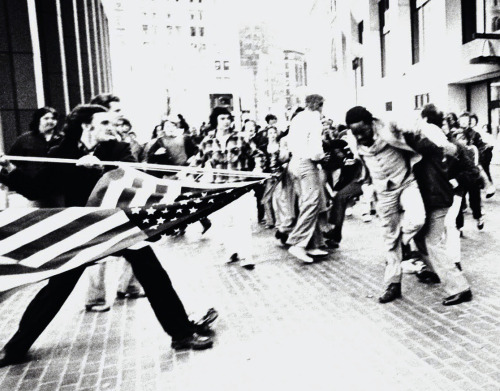
Washington crosses the Delaware, 1776.

The flag over Ft. McHenry, 1814.

Lincoln and McClellan, 1862.

TR and the Rough Riders, 1898.

The Pledge of Allegiance (Lange), 1940s.

Raising the Flag on Iwo Jima, 1945.

Flag on the moon, 1969.

The Soiling of Old Glory, 1976.

Raising the Flag at Ground Zero, 2001.
June 14, 1777: The United States adopts the “Stars and Stripes” as its national flag.
In 1777, the Second Continental Congress passed a resolution that stated:
Resolved, that the flag of the United States be thirteen stripes, alternate red and white; that the union be thirteen stars, white in a blue field, representing a new Constellation.
The new naval ensign (replacing the first, which still incorporated the Union Jack into its design) eventually became the national flag of the new United States. In honor of the 140th anniversary of this event, President Woodrow Wilson declared in 1916 that June 14th would henceforth be celebrated as Flag Day.
Other facts about the American flag:
- The first change to the number of stars came in 1795, when two were added to the original thirteen for Vermont and Kentucky. Two stripes were also added, but it was decided in 1818 that the number of stripes should thereafter remain at thirteen.
- The flag design longest in use is the current fifty-star design. The flag was last changed in 1960, after Hawaii gained statehood in 1959.
- The flag has been modified twenty-six times since its adoption.
- The designer of the 50-star flag was Robert Heft, who was in high school at the time. His design was for a school project, which he received a B- on… until the U.S. government officially adopted his design.
- Six American flags were placed on the moon (by Apollo astronauts). The first was planted by, of course, Neil Armstrong and Buzz Aldrin.
- The National Flag Code.